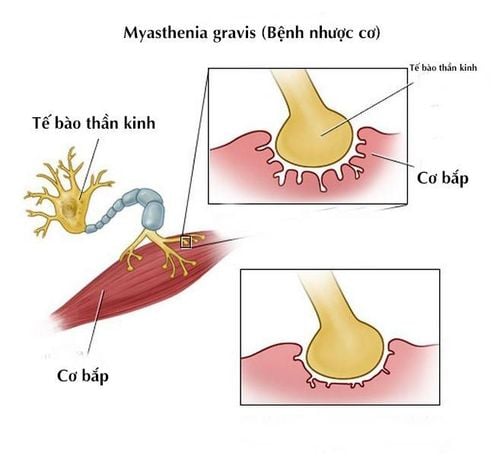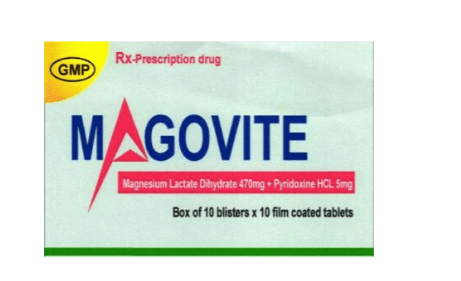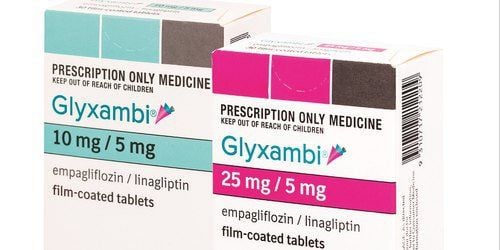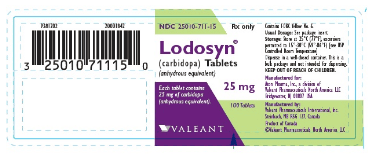This is an automatically translated article.
The article is professionally consulted by Master, Doctor Huynh An Thien - Department of Medical Examination & Internal Medicine - Vinmec Danang International General Hospital.
Myasthenia gravis is a rare disease, which is a disorder of neuromuscular transmission, causing many dangerous complications such as drooping eyelids, difficulty swallowing, shortness of breath, ... even death. Currently, the treatment of the disease is still difficult.
1. What is myasthenia gravis?
Myasthenia gravis is an autoimmune disease that results in conduction disturbances at the nerve-muscle junctions. As a result, the function of the muscular system is reduced. Patients show signs of muscle weakness gradually, worse at the end of the day and after exercise. Although the muscle structure and health in other organ systems are normal, the patient cannot do anything. In typical episodes, the patient cannot even lift his arm.The disease can occur at any age, but the frequency is more common in women under 40 years old and over 70 years old, men over 50 years old. The prevalence is 5/100,000 people. Patients with myasthenia gravis are often hospitalized late, leading to shortness of breath, respiratory failure, and rapid death.
2. Mechanism of myasthenia gravis
Normally, muscles contract and move thanks to nerve impulses arising from the brain, passing through the place of information exchange between nerve fiber endings and cell membranes (synapses) thanks to a neurotransmitter called neurotransmitter. is acetylcholine. In cases of myasthenia gravis, there is a phenomenon that the patient's body produces an antibody that destroys acetylcholine receptors, preventing acetylcholine from being transported to the posterior end of the synapse. As a result, nerve impulses cannot be transmitted and muscles cannot move, leading to muscle weakness and paralysis - a manifestation of myasthenia gravis.The muscles affected by myasthenia gravis are the striated muscles, which govern voluntary movement of the body. The most commonly affected muscle groups are the muscles of the face, eyes, limbs, muscles that control chewing, swallowing, talking, etc. The respiratory muscles can also be affected.
3. Common injuries in patients with myasthenia gravis
Eyelid muscle damage: Eyelid ptosis is the earliest manifestation. Patients have both eyelids drooping, often uneven drooping and worsening over time of the day (usually not obvious when waking up). At this time, the patient who wants to look straight will have to raise his head, tilt his neck. When the eye muscle is damaged, the patient's pupillary reflex is weakened;
4. Doctor's advice for patients with myasthenia gravis
With myasthenia gravis, the patient needs to pay close attention to the factors that contribute to the aggravation of the disease in order to control the progression of the disease. Patients should note the following:
Ensure adequate nutrition, eat enough nutrients, fully supplement potassium from bananas and papaya because potassium deficiency can cause very severe muscle paralysis; Preventing bacterial infections (oral, pharynx,...) while using immunosuppressive drugs; Do not arbitrarily use drugs that can cause muscle weakness such as sedatives, muscle relaxants, anticonvulsants,...; Do not arbitrarily quit while being monitored for treatment of myasthenia gravis because the fact shows that most cases of severe myasthenia gravis, rapidly progressing, causing respiratory failure requiring emergency hospitalization are because the patient stopped taking the drug because stable disease, or switch to drugs of unknown origin; Avoid nervous tension, stay in too hot, too cold temperatures; Do not exercise, work with too high intensity and continuously; When there are symptoms of progressive myasthenia gravis, it is necessary to immediately go to specialized medical facilities for monitoring and treatment advice. Myasthenia gravis greatly affects the quality of life, increasing the risk of death in patients in the advanced stage. Therefore, when there are abnormal symptoms warning of myasthenia gravis such as drooping eyelids, muscle weakness, shortness of breath,... the patient should go to the doctor for timely diagnosis and treatment.
Please dial HOTLINE for more information or register for an appointment HERE. Download MyVinmec app to make appointments faster and to manage your bookings easily.














